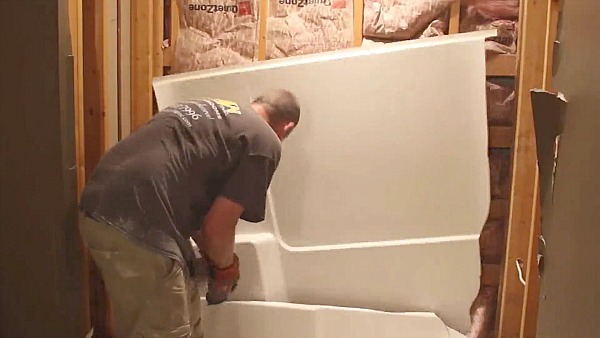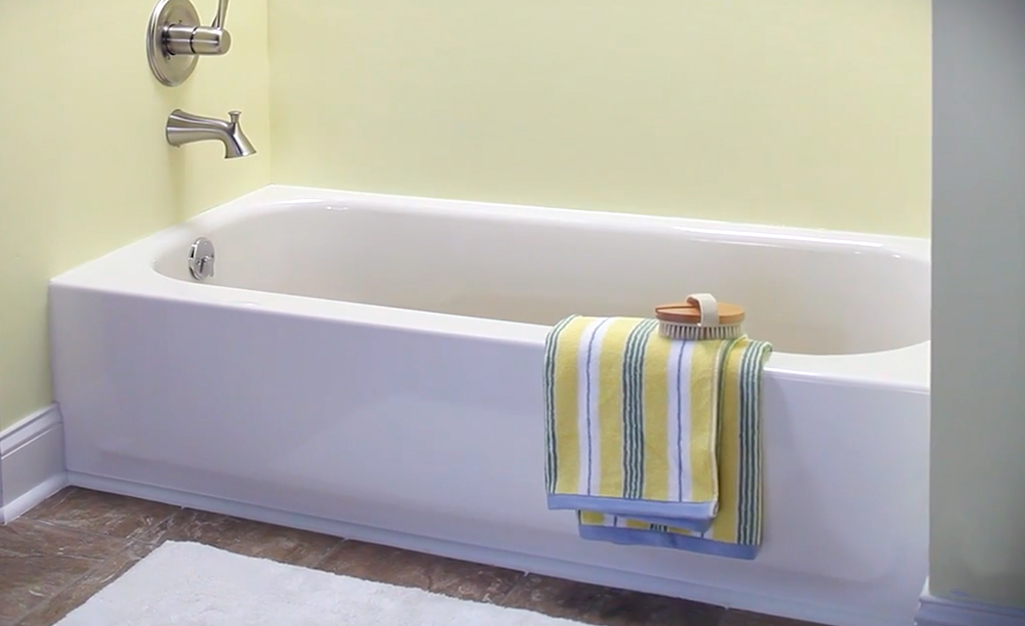Tools You Need to Set Up a New Tub
Tools You Need to Set Up a New Tub
Blog Article
They are making a number of great points on How to Install a Bathtub Yourself overall in this content directly below.

Mounting a bathtub isn't precisely brain surgery, but it does need solid plumbing, woodworking, and often, tiling skills. Changing an old bathtub with a brand-new one is likewise a moderately hard project. If the old bathtub is readily obtainable, the project can relocate immediately; if you have to open up a wall surface to eliminate the old bathtub and place the new bathtub, the job is a lot harder. In either situation, the task is within a home handyman's abilities, although you will need an assistant to move out the old bathtub and set in the brand-new one. Ensure you have certified yourself for the task and also are comfortable trying it. As opposed to employing a service provider to take over a halfway-completed project, it is far better to think about using one before you begin. Opportunities are you may need a specialist plumber to make tube connections.
This short article will certainly help you install a brand-new bath tub in your restroom if you have currently acquired a new tub as well as do not require to change the arrangement of your previous water system pipelines.
Your devices as well as product list should comprise the following:
Removing Old Touches
If you need to replace old taps with new ones as a part of your installation, then the first thing you must do is separate the water. After doing so, activate the taps to drain any water continuing to be in the system. The procedure of getting rid of the existing taps can be rather troublesome as a result of the limited accessibility that is often the case.
Utilize a basin wrench (crowsfoot spanner) or a tap tool to undo the nut that links the supply pipes to the taps. Have a fabric ready for the remaining water that will certainly originate from the pipelines. As soon as the supply pipelines have actually been gotten rid of, utilize the same tool to loosen the nut that holds the taps onto the bath/basin. You will certainly need to stop the single taps from turning during this process. When the faucets have actually been eliminated, the holes in the bath/basin will have to be cleaned of any old sealing compound.
Before going on to fit the brand-new faucets, contrast the pipeline links on the old faucets to the brand-new faucets. If the old faucets are longer than the brand-new faucets, then a shank adapter is required for the new taps to fit.
Fitting New Taps
If the tails of the new taps are plastic, then you will require a plastic adapter to stop damages to the string. One end of the adapter fits on the plastic tail of the faucet and also the various other end provides a connection to the existent supply pipes.
If you require to fit a monobloc, after that you will certainly require reducing couplers, which attaches the 10mm pipeline of the monobloc to the typical 15mm supply pipeline.
Next off, place the faucet in the installing hole in the bath/basin guaranteeing that the washers remain in area in between the faucet as well as the sink. Secure the tap in position with the supplier supplied backnut. When the tap is safely in place, the supply pipes can be attached to the tails of the faucets. The taps can either be linked by utilizing corrugated copper piping or with normal tap ports. The previous kind should be linked to the faucet ends initially, tightening only by hand. The supply pipelines can later be linked to the other end. Tighten both ends with a spanner after both ends have actually been linked.
Installing the Bath tub
Utilizing the two wood boards under its feet, put the bathtub in the called for setting. The wood boards are practical in evenly spreading out the weight of the bathtub over the location of the boards rather than concentrating all the weight onto 4 small factors.
The following goal is to ensure that the tub is leveled all round. This can be accomplished by checking the level as well as readjusting the feet on the bathtub till the level checks out level.
To set up taps, fit all-time low of the furthest flexible faucet adapter to the ideal supply pipeline by making a compression join; after that do the exact same for the various other tap.
Turn on the water supply as well as check all joints as well as new pipework for leakages and tighten them if essential. Fill up the bath tub and additionally check the overflow electrical outlet and also the typical electrical outlet for leaks.
Ultimately, deal with the bath paneling as defined in the producer's user's manual. Tiling and sealing around the tub ought to wait till the bathtub has been utilized at the very least when as this will settle it into its last placement.
Getting ready for the Setup
To start with, the sustaining frame supplied with the bathroom needs to be fitted (if required) according to the manufacturer's instructions. Next, fit the faucets or mixer to the tub. When suitable the tap block, it is essential to make certain that if the faucet comes with a plastic washer, it is fitted in between the bath and the taps. On a plastic bath, it is likewise practical to fit a sustaining plate under the faucets device to stop strain on the bathtub.
Fit the versatile tap ports to the bottom of both faucets making use of 2 nuts as well as olives (occasionally provided with the bathtub). Fit the plug-hole outlet by smearing mastic filler round the sink electrical outlet hole, and then pass the outlet through the hole in the bath. Use the nut supplied by the manufacturer to fit the plug-hole. Take a look at the plug-hole electrical outlet for an inlet on the side for the overflow pipe.
Next, fit the end of the flexible overflow pipe to the overflow outlet. Afterwards, screw the pipeline to the overflow face which need to be fitted inside the bathroom. See to it you make use of every one of the provided washing machines.
Link the catch to the bottom of the waste electrical outlet on the bathtub by winding the thread of the waste electrical outlet with silicone mastic or PTFE tape, and also screw on the catch to the electrical outlet. Link the bottom of the overflow tube in a similar manner.The bath ought to now be ready to be suited its final placement.
Tiling Around the Bath tub
In the location where the bath meets the tile, it is necessary to seal the accompanies a silicone rubber caulking. This is necessary as the installation can relocate enough to crack a rigid seal, creating the water to permeate the wall between the bathroom as well as the tiling, causing problems with dampness and also feasible leaks to the ceiling listed below.
You can select from a variety of coloured sealers to blend in your components and installations. They are offered in tubes and also cartridges, as well as are capable of securing spaces up to a size of 3mm (1/8 inch). If you have a larger void to fill up, you can load it with spins of soaked paper or soft rope. Remember to constantly fill up the bathtub with water prior to sealing, to permit the motion experienced when the bathtub remains in usage. The sealant can crack rather very early if you do not take into consideration this movement before sealing.
Conversely, ceramic coving or quadrant tiles can be made use of to border the bath or shower tray. Plastic strips of coving, which are easy to use and also cut to dimension, are also conveniently available on the marketplace. It is recommended to fit the tiles making use of water-resistant or water-proof sticky and also cement.
Bathtub Installation
How Important Is A Bathtub To Your Home?
High-quality baths, showers, and other bathroom updates are necessary when considering a smart investment in your home. It’s a room that you go to every day and one that is constantly being used by guests.The bathroom is one of the top trafficked rooms in a home and also one of the most valuable in terms of home resale.
Install Piping Before Tub
You will be using your existing drain and waste vent system, but pipes required include the hot and cold water supply lines and a pipe leading to a shower head. A mixing valve and shower head are also needed. Air chambers may be required.
Position the Tub
Lower the tub into place so that the continuous flange fits against the wall studs and rests on 1’x4' or 2’x4' supports. Anchor the tub to the enclosure with nails or screws inserted through the flanges into the studs.
NOTE: Remember, bathtubs and shower stalls may require support framing. A bathtub filled with water is extremely heavy, so check building codes and framing support before installing the tub.
Assemble Drain Connections
Assemble the bathtub drain connections by connecting the tub overflow with the tub drain above the trap, not beyond it. The trap will have a compression fitting that screws over the arm of the overflow assembly.
Place a Pipe For the Shower Head
First, locate a brass female threaded winged fitting and attach it to a framing support via a screw or a nail. Then run a pipe up the wall for the shower head. Sweat or solder the other side of the brass fitting to the top of the pipe.
Attaching Hot and Cold Water Lines
Attach your water lines for both hot and cold by sweating these directly into the hot and cold ports of the mixing valve. The mixing valve will be how water enters the tub’s system, not by the pipes themselves.
Install the Spout
Extend a piece of 1/2 inch pipe, or whichever length is specified in the manufacturer’s instructions, for the tub spout. Sweat on a male threaded fitting at the end of the pipe or use a brass nipple of the proper length and a 1/2 inch cap.
NOTE: At this point you should have your rough-in plumbing work inspected before proceeding further.
Check For Leaks
Restore the water pressure and check the drain connection and the supply pipes for any sign of leaking.
estore the Bathroom Wall
Replace the wall with moisture-resistant drywall as a base for your wall covering. Seal the joints between the wall and your new tub with silicone caulk as protection against water seepage.
https://www.berkeys.com/2016/12/02/bathtub-installation-dallas/

I am very drawn to A Step-by-Step Guide to Installing a Bathtub and I'm hoping you enjoyed the blog posting. Are you aware of another individual who is fascinated about A Step-by-Step Guide to Installing a Bathtub? Feel free to promote it. Kudos for your time. Please pay a visit to our website back soon.
Booking
Report this page